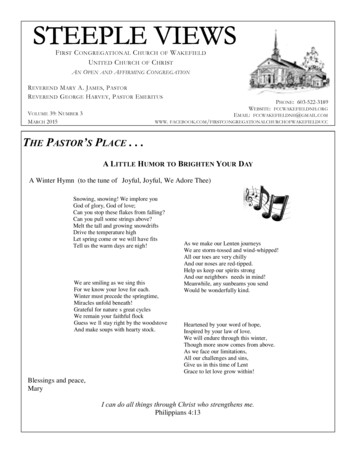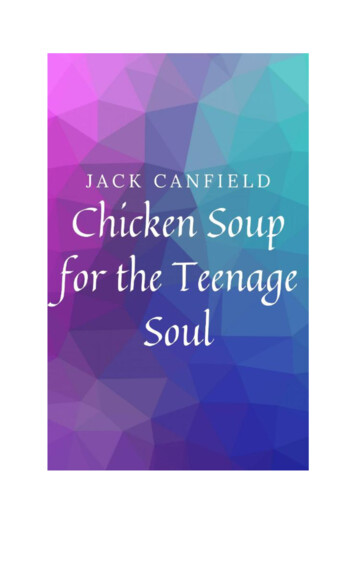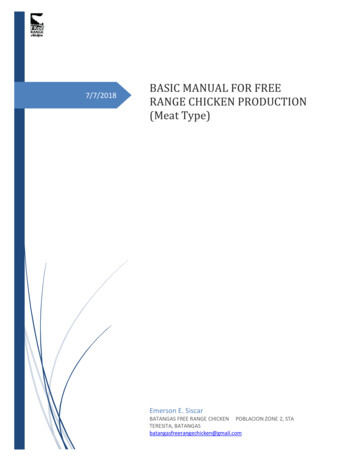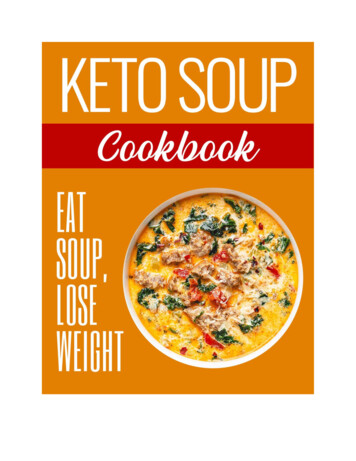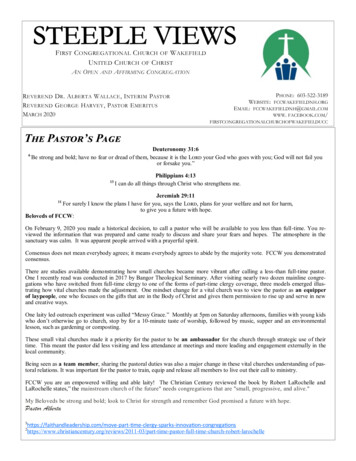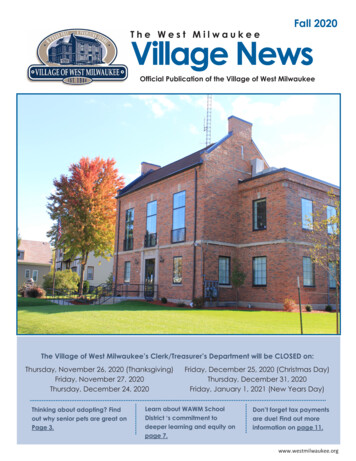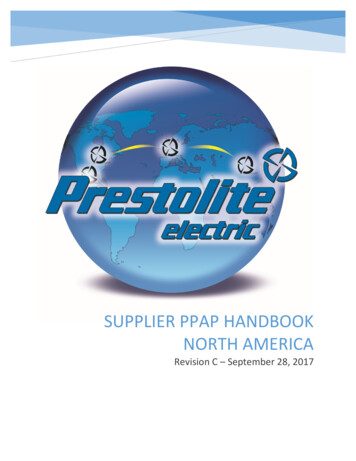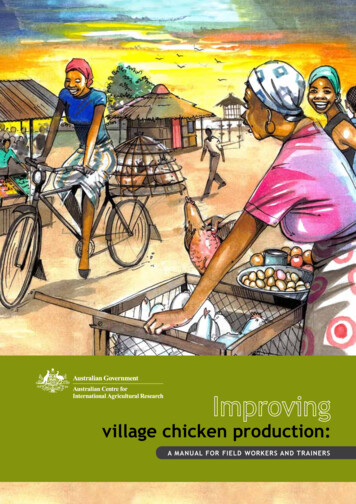
Transcription
village chicken production:a manual for field workers and trainers
village chicken production:a manual for field workers and trainersChristine Ahlers, Robyn Alders, Brigitte Bagnol,Ana Bela Cambaza, Mohamed Harun, Richard Mgomezulu,Halifa Msami, Bob Pym, Peter Wegener, Ed Wethliand Mary Young2009
The Australian Centre for International Agricultural Research (ACIAR)was established in June 1982 by an Act of the Australian Parliament.ACIAR operates as part of Australia’s international developmentcooperation program, with a mission to achieve more productiveand sustainable agricultural systems, for the benefit of developingcountries and Australia. It commissions collaborative research betweenAustralian and developing-country researchers in areas where Australiahas special research competence. It also administers Australia’scontribution to the International Agricultural Research Centres.Where trade names are used this constitutes neither endorsementof nor discrimination against any product by the Centre.ACIAR MONOGRAPH SERIESThis series contains the results of original research supportedby ACIAR, or material deemed relevant to ACIAR’s researchand development objectives. The series is distributedinternationally, with an emphasis on developing countries. Commonwealth of Australia 2009This work is copyright. Apart from any use as permitted underthe Copyright Act 1968, no part may be reproduced by anyprocess without prior written permission from the Commonwealth.Requests and inquiries concerning reproduction and rights shouldbe addressed to the Commonwealth Copyright Administration,Attorney-General’s Department, Robert Garran Offices, NationalCircuit, Barton ACT 2600 or posted at http://www.ag.gov.au/cca .Published by the Australian Centre forInternational Agricultural Research (ACIAR)GPO Box 1571, Canberra ACT 2601, AustraliaTelephone: 61 2 6217 0500aciar@aciar.gov.auAhlers C., Alders R.G., Bagnol B., Cambaza A.B., Harun M.,Mgomezulu R., Msami H., Pym B., Wegener P., Wethli E.and Young M. 2009. Improving village chicken production:a manual for field workers and trainers. ACIAR MonographNo. 139. Australian Centre for International Agricultural Research:Canberra, 194 pp.ISBN 978 1 921531 57 6 (print)ISBN 978 1 921531 58 3 (online)Technical editing by Clarus Design Pty LtdDesign by WhiteFoxPrinting by Goanna Print
ForewordPoultry have contributed to human health and wellbeing for millennia. For ruralcommunities, poultry continue to be an integral part of farming systems andhousehold economies. For cities and towns, where an increasing proportionof people now live, large- and small-scale commercial poultry industries playa critical role in providing safe, good-quality products for urban consumers.In many countries, commercial and household poultry are located within thesame communities, and improvement programs designed to increase thecapacity of producers and introduce new technologies and practices canhave widespread impact.Australia has supported the implementation of effective village chickenproduction programs in Asia, Africa and Latin America, including severalresearch projects funded by the Australian Centre for International AgriculturalResearch (ACIAR). This investment in research and development, alwaysin collaboration with producers, traders and other stakeholders, has beenshown to increase poultry numbers, household purchasing power, homeconsumption of chicken products (resulting in improved nutrition for families)and the decision-making power of women. Village chicken improvementprograms have the potential to contribute to each of the MillenniumDevelopment Goals and to do so for the most vulnerable families indeveloping countries.This is the fourth manual on improvements to village chicken productionsupported by ACIAR.1 These manuals aim to fill gaps in the training literature,which has dealt mostly with intensive commercial production or backyardproduction in developed countries. This manual is focused on developingcountries and describes husbandry practices and biosecurity measures forvillage chickens that can be implemented using locally available resources.These measures will lead to both increased productivity and improvedprotection from disease in village chicken systems.The manual is comprehensive, covering many aspects of production andhealth. It draws on the research results of a number of ACIAR-fundedprojects that provided a sustainable base to the control of Newcastle disease(ND) in village chickens using thermotolerant vaccine. Newcastle diseaseremains a major constraint to poultry production worldwide and these projectsrecognised that benefits to farmers can be further increased when otherhealth and production issues are tackled in addition to vaccination.Much of the content of the manual has been developed to this finalstage during a project funded by the Australian Agency for InternationalDevelopment (AusAID) from 2002 to 2005, to implement the Southern AfricaNewcastle Disease Control Project (SANDCP) in Malawi, Mozambique and1Controlling Newcastle disease in village chickens: field (Alders and Spreadbrow 2001), training (Alders et al. 2002)and laboratory (Young at al. 2002) manuals (ACIAR Monographs 82, 86 and 87, respectively)3
Tanzania. SANDCP followed on from 7 years of ACIAR-funded research onND control conducted by the Mozambican National Institute for VeterinaryResearch and the University of Queensland.It is pleasing to note that the success of SANDCP, including the use of thetraining material in this manual, has gone well beyond the control of ND inthese three countries and has laid a foundation for responding effectivelyto the worldwide epidemic of highly pathogenic avian influenza and indeveloping livelihood strategies for communities affected by high levelsof HIV/AIDS.ACIAR will continue to support research that contributes to food security,food safety and ecologically sustainable livestock production, and torecognise that building capacity in poultry health and production is ofspecial significance to developing countries.Peter CoreChief Executive OfficerACIAR4
ContentsForeword3About the PART 1 VILLAGE CHICKENS AND VILLAGE CHICKEN FARMERS151Introduction161.1Village chickens defined161.2About this manual171.3How to use this manual181.4Promoting improved village chicken production using minimalexternal inputs191.5Gender and village chickens221.6Newcastle disease and avian influenza control, and otherproduction improvements221.7Village chicken production and HIV/AIDS mitigation231.8Organic village chicken production231.9Village chicken production and wildlife conservation232General information about village chicken production252.1The village chicken system252.2Comparisons between village chickens and commercialchicken production262.3Production characteristics of village chickens272.4The scavenging feed resource base293 Working together with male and female village chicken producers3.1Introduction303.2Phase 1: Raising awareness and identifying problems313.3Phase 2: Identifying solutions and planning activities323.4Phase 3: Implementing activities333.5Phase 4: Evaluating the results33PART 2430HOUSING, NUTRITION AND MANAGEMENT35Chicken housing and shelter364.1Introduction364.2Types of housing364.3Constructing a chicken house384.4Roosts/perches384.5Maintaining a chicken house394.6Provision of nests394.7Protection from predators and theft415
56Nutrition435.1Water435.2Scavenging445.3How a chicken digests food455.4What chickens need in their feed465.5Feed resources485.6Supplementary feeding505.7Feedstuffs that might be offered to chickens, and their nutrient content 545.8Feeding confined chickens54Flock management576.1Keeping the flock healthy and productive576.2Flock size586.3General hygiene596.4Laying, brooding and hatching606.5Raising young chicks686.6Breeding726.7Meat production (sale and consumption)756.8Egg production (sale and consumption)806.9Record keeping887 Disorders related to poor husbandry or nutrition89PART 3 DISEASES AND THEIR CONTROL918 Disease in village chickens928.1Introduction928.2Causes of disease928.3Transmission of infectious diseases938.4Notifiable diseases948.5Diagnosis of poultry disease949 Disease control101029.1Introduction1029.2Tools used to control diseases in village chickens1029.3How to prevent a disease from entering a village chicken flock1049.4How to control a disease outbreak in a village chicken flock106Newcastle disease10810.1Cause and impact10810.2Transmission10810.3Species affected11010.4Clinical signs11010.5Post-mortem findings11210.6Field diagnosis of Newcastle disease11210.7Investigating vaccination failure11310.8Controlling Newcastle disease11410.9Reporting Newcastle disease11910.10 Differential diagnosis of Newcastle disease in village chickens6119Improving village chicken production: a manual for field workers and trainers
1112Other infectious diseases of village chickens12111.1Introduction12111.2Avian influenza (fowl plague)12311.3Chronic respiratory 11.6External parasites (fleas, mites etc.)13311.7Fowl cholera (pasteurellosis)13711.8Fowl pox13911.9Fowl typhoid14011.10 Infectious bursal disease/Gumboro disease14111.11 Infectious bronchitis14311.12 Infectious coryza14411.13 Infectious laryngotracheitis14511.14 Marek’s disease14611.15 Pullorum disease (bacillary white diarrhoea)14711.16 Internal parasites148Concluding remarks150Bibliography151Appendixes1551How to use this manual as part of a training course for livestock officers,extension agents, community animal health workers or farmers156Participatory community exercises for identifying problemsassociated with village chicken production1573Collection of blood samples1734Post-mortem examination1755Collection of samples for laboratory examination1836Sources of further information1942Contents7
About the authorsAuthorDescriptionContact detailsChristine AhlersA poultry veterinarian with1. FAO Regional Office for Asia andexperience in both commercial andthe Pacific, 39 Phra Atit Road,family poultry, working for the FoodBangkok 10200, Thailandand Agriculture Organization of2. Soomskamp 12, 27324the United Nations in its RegionalEystrup, GermanyOffice for Asia and the PacificEmail: c-ahlers@gmx.deRobyn AldersA village poultry specialist with the 1. KYEEMA Foundation, GPO BoxInternational Rural Poultry Centre3023, Brisbane, Queensland 4001,of the KYEEMA Foundation and theAustralia.Cummings School of Veterinary2. International Program, DEPH,Medicine, Tufts University, USACummings School of VeterinaryMedicine, Tufts University, 200Westboro Road, North GraftonMA 01536, USAEmail: robyn.alders@gmail.comBrigitte BagnolSocial anthropologist with theUniversity of the Witwatersrand,Johannesburg, South Africa andthe International Rural PoultryCentre of the KYEEMA FoundationPostnet suite 118 Private Box X1,Melrose Arch, 2076 Johannesburg,South AfricaEmail: bagnolbrigitte@gmail.comAna Bela Cambaza A veterinarian working for theNational Veterinary ServicesDirectorate who has been involvedwith the control of Newcastledisease in village chickenssince 2004.CP 1406, Maputo, MozambiqueMohamed HarunVeterinary physiologist specialisingin the biology of incubation andtemperature regulation in neonatesof avian speciesVeterinary Faculty, University ofEduardo Mondlane, PO Box 257,Maputo, MozambiqueAnimal production specialist with18 years’ experience in livestockproduction including poultry.He has been actively involvedin control of Newcastle diseasein village chickens using athermotolerant I-2 ND vaccinesince 2003.Department of Animal Health andLivestock Development, PO Box2096, Lilongwe, MalawiRichardMgomezuluHalifa Msami8Email: controlodn@yahoo.com.brEmail: kabil.harun@tvcabo.co.mzEmail: richardag mgomezulu@yahoo.co.ukPrincipal veterinary research officer, Central Veterinary Laboratory, POTanzania national coordinator forBox 9254, Dar Es Salaam, TanzaniaNewcastle disease control; poultryEmail: hmmsami@gmail.compathologist with several yearsexperience working on villagechicken developmentImproving village chicken production: a manual for field workers and trainers
AuthorDescriptionContact detailsBob PymA poultry geneticist by trainingwith interest and involvementin small-scale family poultryproduction in the developingcountries of South-East Asia andSouthern AfricaSchool of Veterinary Science,University of Queensland, St Lucia,Queensland 4072, AustraliaA community development andextension specialist who has alsohelped design training materialsand programs for the controlof Newcastle disease in villagechickensSchool of Natural and Rural SystemsManagement,University of Queensland,St Lucia Campus, Queensland 4072,AustraliaA poultry specialist with manyyears’ experience of small-scalechicken development in rural andperi-urban areasPO Box 171, Ifafa Beach 4185,KwaZulu-Natal, South AfricaA veterinary pathologist withseveral years’ experience in controlof Newcastle disease in villagepoultry using thermotolerant I-2Newcastle disease vaccineKYEEMA Foundation, GPO Box3023, Brisbane, Queensland 4001,AustraliaPeter WegenerEd WethliMary YoungAbout the authorsEmail: r.pym@uq.edu.auEmail: p.wegener@uq.edu.auEmail: edwethli@absamail.co.zaEmail: mary p young@yahoo.com9
AcknowledgmentsSincere thanks to go to the many farmers, extension workers, livestockspecialists and veterinarians who have contributed valuable informationand provided feedback on the contents of this manual.We acknowledge the support of the Australian Agency for InternationalDevelopment through the Southern Africa Newcastle Disease ControlProject (SANDCP) and the Australian Centre for International AgriculturalResearch in the preparation of this manual. Dr Ed Wethli was working asan International Fund for Agricultural Development consultant at the timehis contribution was made. SANDCP was implemented by GRM InternationalPty Ltd in collaboration with the International Rural Poultry Centre of theKYEEMA Foundation.Special thanks go to Mr Razac Chame for his patience and artistic excellencein providing all of the illustrations for this manual.10Improving village chicken production: a manual for field workers and trainers
AbbreviationsACIARAustralian Centre for International Agricultural ResearchAIDSacquired immune deficiency syndromeCRDchronic respiratory disease Cdegrees CelsiusFAOFood and Agriculture Organization of the United NationsFGDfocus group discussionggramsHIVhuman immunodeficiency virusHPAIhighly pathogenic avian influenzaIBinfectious bronchitisIBDinfectious bursal disease, also known as Gumboro diseasekgkilogramLlitremmetrem2square metremLmillilitreNDNewcastle diseaseNGOnon-government organisationPRAparticipatory rural appraisalOIEWorld Organisation for Animal Health (OrganisationInternationale des Epizooties)PPEpersonal protective equipmentSFRBscavenging feed resource base11
GlossaryAntibodyA protein produced by specialised B cells after stimulationby an antigen. Antibodies bind with antigens on foreignorganisms to help inactivate them. Each antibody can bindto only one specific antigen.BiosecurityAny practice or system that prevents the spread ofinfectious agents from infected to susceptible animals,or prevents the introduction of infected animals intoa herd, region, or country in which the infectionhas not yet occurred. More specifically, biosecuritycombines ‘bioexclusion’, i.e. measures for preventing apathogen from being introduced into a herd/flock, and‘biocontainment’, stopping the spread of a pathogenamong animal groups within a farm or of being releasedfrom the farm.BroodyIf a hen ( female chicken) is broody, she is ready tolay eggs and sit on them.CloacaThe internal cavity into which the intestinal, urinary andgenital canals empty in birds. In females it also servesas the depository for sperm. The cloaca has an opening(vent) for expelling its contents from the body.CockerelA young male chicken.DroppingsThe excrement (i.e. manure) produced by animalsand birds.EmbryoAn animal that is developing, either in its mother’s wombor in an egg, or a plant that is developing in a seed.EndemicAn endemic disease or condition is one that is regularlyfound and very common among a particular group or ina particular area.FomitesInanimate objects such as boots, clothing, equipment,instruments, vaccination needles, vehicles, crates orpackaging that can transmit an infectious agent to anew host mechanically. Fomites become contaminatedbut not infected.ForageFood grown for livestock consumption.GleaningsCereal remnants in the field after harvesting.GenotypeThe particular type and arrangement of genes in anorganism.I-2 vaccineThermotolerant, live, avirulent Newcastle disease vaccine.12Improving village chicken production: a manual for field workers and trainers
LipidA substance such as a fat, oil or wax that dissolvesin alcohol but not in water and is an important part ofliving cells.MechanicaltransmissionThe transfer of an infection from one animal to a new hostwhere the transmitter is not infected, in that tissues arenot invaded and the agent does not multiply. Fomites areoften involved in mechanical transmission.MutationA sudden change from the parent type in one or moreheritable characteristics, caused by a change in a geneor a chromosome.OrganicOrganic produce, such as plants and animals grown forfood, is produce grown without the use of insecticidesand other synthetic chemicals.PathognomonicA pathognomonic sign is a specific sign whose presencemeans, beyond any doubt, that a particular disease ispresent.PulletA young, female domestic fowl, especially a chicken,from the time she begins to lay until first moult.RalesA clicking, rattling, or crackling noise heard during inhalation.ReassortmentThe fragmentation and reassembly of the genetic materialof two similar viruses that are infecting the same cell.RoosterAn adult male chicken.SnickA high-pitched sound associated with sneezing in poultry.ThermolabileA thermolabile agent loses activity (especially infectivity)at elevated temperatures.ThermotolerantA thermotolerant agent retains activity (especially infectivity)at elevated temperatures.TropismA preference for a particular location or direction. Thesite preferred by a virus (e.g. ND virus) for replicationwithin the body.VentThe external opening of the cloaca, through which eggsand droppings pass.VerticaltransmissionPassage of a disease-causing agent (a pathogen) verticallyfrom mother directly to her offspring during pregnancy orlactation. In the case of poultry, the transmission is fromthe hen to her chick via the egg.VirulenceRefers to the degree of pathogenicity of a microbeor, in other words, the relative ability of a microbeto cause disease.Glossary13
PART 1Village chickens and village chicken farmersThe improvement of village chicken production can have a profound effecton the wellbeing of rural families. The effective, low-cost interventionsdescribed in this manual can directly contribute to poverty alleviation,household food security, income generation, HIV/AIDS mitigation andwildlife conservation. Working with male and female farmers to improve theproduction of their village chickens also provides opportunities to enhancetheir understanding of nutrition, stock management, and the origins anddevelopment of diseases. Farmers’ knowledge of poultry and human nutrition can be increased inparallel. Since women are often the family members responsible for boththe care of poultry and the preparation of the family’s meals, this approachcan bring big benefits. Once the production of village chickens improves, farmers take a greaterinterest in managing their stocks of birds by monitoring the availability oflocal feed resources and assessing options for the off-take of birds by saleor other means. Ensuring that farmers understand disease processes is an essential stepas it is very difficult to improve biosecurity practices if they do not believethat diseases are caused by infectious agents.Before promoting improved management and disease control in an area orvillage, it is important to understand the existing environment in which villagechickens are produced. Part 1 of this manual therefore provides, in threechapters, background material on the role of village chickens and wherethey fit into the rural production system. It also describes how to involve thecommunity in any activities relating to village chicken production. It shouldbe read and understood before deciding on implementing any of theinterventions described in Parts 2 and 3.A number of terms that may be unfamiliar are defined in the glossary at thebeginning of the manual.15
1Introduction1.1Village chickens definedVillage chickens are the most common type of livestock in many rural areas.Even very poor households with few labour resources will normally keep somechickens. ‘Village’ chickens are also known as rural, indigenous, scavenging,traditional or family chickens, and have various names in local languages.There are several definitions of village, rural or family poultry. The maindifferences between them relate to the degree to which aspects of moreintensive and commercial chicken production systems are included. For thepurposes of this manual, family poultry is used as a more general categorythat also includes production systems more commonly found in urbanareas, where a family raises chickens in an enclosure with a greater levelof purchased inputs. The term village poultry, on the other hand, refers tothe extensive production systems most commonly found in rural areas, andusually involves indigenous chicken genotypes. The information provided inthis manual is directed toward improvements to village poultry systems andaims to maintain the basic advantages of this system, which are low inputsand, consequently, low risk. Although the emphasis is on village chickens,many of the recommendations in this manual can be applied to other poultryspecies, such as ducks, turkeys and guinea fowl.Village poultry: comprise local genetic stock (sometimes, but rarely, interbredwith improved stock) are raised extensively in relatively small numbers (between1–50 at any time, although more commonly 5–15 birds) are not usually confined and obtain most of their diet fromscavenging for food and water around the home (includinghousehold wastes) and village require minimal investment in inputs, with most if not all of theinputs generated around the home engage labour inputs that are not salaried but are drawn fromthe family, with women and children commonly most responsiblefor their care production is geared essentially toward home consumptionand savings (a living bank) for small expenses such as schoolfees and medicines.Animal protein consumed in rural areas frequently comes from village chickenmeat and eggs. Chickens can also be sold or bartered to meet family needs16Part 1 Village chickens and village chicken farmers
such as medicines, clothes and school fees. In this way, they act as a readysource of cash for emergencies and small purchases. Village chickensprovide manure and play a role in pest control. They are also important forspecial festivals or to meet social obligations, and they are essential for manytraditional ceremonies and methods of treating illnesses. They are generallyowned and managed by women and children, and are often an essential partof households headed by women.Chicken meat and eggsChicken meat and eggs provide a readily available, high-qualitysource of proteins, vitamins and micronutrients. Eggs are anexcellent source of iron, zinc and vitamin A, all of which are essentialto health, growth and wellbeing. Chickens and eggs contribute to anutritious, balanced diet, which is especially important for children,nursing mothers and people who are ill.Village chickens play a very important role in poor rural communities in thatthey can convert feed available around a house or village (the ‘scavengingfeed resource base’, SFRB—see Section 2.4) into highly nutritious, wellappreciated products.Although the output of traditional village chickens in terms of weight gainand number of eggs per hen per year is low, it is obtained with minimallabour and other inputs. This factor of low input and, consequently, low riskis one of the major advantages of village chicken production. It is importantto remember that it is undesirable for any initial improvements to villagechicken production to significantly raise the labour costs or financial risksinvolved in the activity.Simple changes in management of village chickens can significantlyimprove production and the living conditions of many rural families in termsof enhanced nutrition and income generation through the sale of surpluschickens or eggs. Improved village chicken production is therefore a low-costand important aspect of rural development.1.2About this manualThis manual follows on from ‘Controlling Newcastle disease in villagechickens: a training manual’ (Alders et al. 2002). That manual and associatedhandbooks (see the Bibliography for a list of titles) were designed to helpextension workers and community vaccinators to understand how Newcastledisease (ND) can be controlled in rural areas.In many places, ND is considered the most significant constraint to villagechicken production. Poultry farmers’ familiarity with the high mortality causedChapter 1 Introduction17
by ND has delayed the detection of highly pathogenic avian influenza (HPAI) inmany countries and complicated HPAI control measures. The effective control ofND will facilitate the early detection of incursions of HPAI by reducing mortalityin flocks and improving relations between farmers and animal health authorities.However, once ND is controlled, there are other diseases that will naturallyassume greater importance and which traditionally have received less attentionin research and extension programs. While none of these diseases is likelyto be individually as significant as ND, collectively they are very important andcan markedly reduce the potential benefits from ND control.As ND control improves, producers are motivated to take the next steps inimproving their chicken production. They talk about increasing flock size,controlling other diseases, reducing mortalities from predators, minimisingtheft, improving feeding and organising better marketing systems. Oncea successful ND control program is under way, extension agencies canprepare for the increase in the demand for information by organising trainingand information for extension officers. Until recently, however, most of theinformation relating to chicken production was directed toward intensive orsemi-intensive systems.This manual aims to provide, for extension workers and livestock officers,basic information on the production of traditional village chickens andhow productivity can be improved by introducing appropriate, low-costapproaches. The manual describes the initial steps that can be takento improve village chicken production. More costly techniques, such askeeping birds permanently in chicken houses and supplying only commercialfeed, are not covered in this manual, although information about thesetechniques can be obtained from documents posted on websites listedin the ‘Sources of further information’ section in Appendix 6. Theseother techniques could be tested by farmers after they are comfortableimplementing the suggestions described in this manual and they havea good understanding of the extra costs and labour that would be requiredfor more intensive chicken production.Although this manual includes information on ND, the more comprehensiveND training manual mentioned earlier should be referred to for controllingthis disease in areas where it is endemic. Once ND is under control, or inareas where ND is not endemic, farmers will be have a greater incentive toimplement the measures suggested in this manual.1.3How to use this manualThe manual is in three parts. Part 1 gives general information about village chicken production andhow to work with chicken producers. Part 2 describes management and husbandry practices that will improvechicken production.18Part 1 Village chickens and village chicken farmers
Part 3 deals with various poultry diseases and their control, with specialemphasis on ND.The manual is designed as a practical reference tool for extension workers,livestock officers and field veterinarians. Each chapter details improvementsthat could be applied by village chicken producers. The key extensionmessages of each chapter are summarised at its start.The appendixes provide more detailed information that will assist peopleworking with village chicken producers. While the main part of the manualdeals with practical information that would be of direct use to villagechicken producers, the appendixes are aimed at providing additionaltechnical information. Appendix 1 gives suggestions on how to use this manual as partof a training course. Appendix 2 describes participatory exercises that could be usedwith village communities to identify problems. Appendixes 3, 4 and 5 provide information on sample collectionand serology. Appendix 6 provides sources of other information and furtherreading.The order in which information in the manual could be used couldvary as follows, according to the principal problem to be addressedin a particular area:Principal problemNewcastle disease (ND)Part 1Part 3 (plus ND training manual)Part 2Other diseasesPart 1Part 3Part 2ManagementPart 1Part 2Part 3Supplementary feedingPart 1Part 2Part 31.4Promoting improved village chicken production usingminimal external inputsWhy should extension and development agencies promote improved villagechicken production and why should they promote improvements that requireminimal extra inputs?Village chicken production has traditionally been underrated inimportance as a vehicle for rural development. This
5.7 Feedstuffs that might be offered to chickens, and their nutrient content 54 5.8 Feeding confined chickens 54 6 Flock management 57 6.1 Keeping the flock healthy and productive 57 6.2 Flock size 58 6.3 General hygiene 59 6.4 Laying, brooding and hatching 60 6.5
